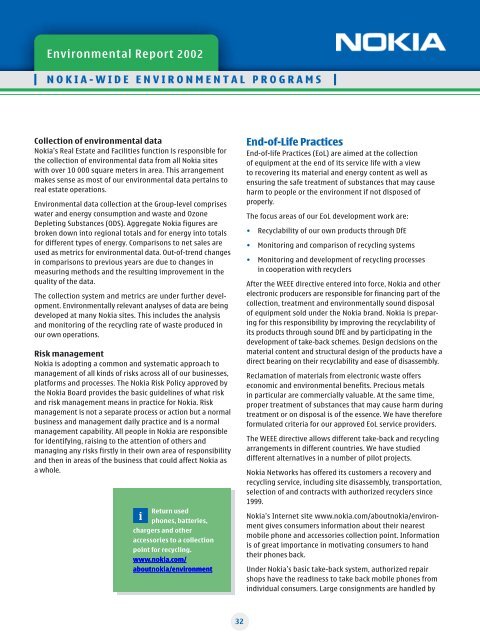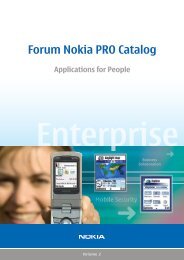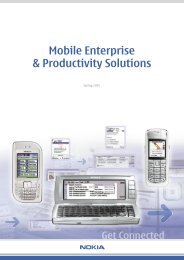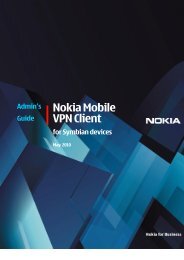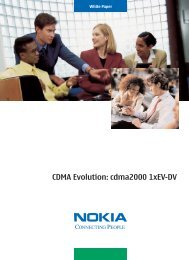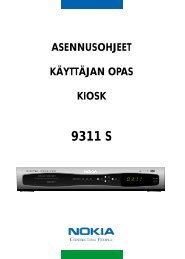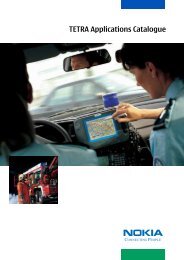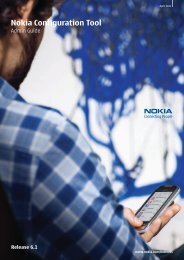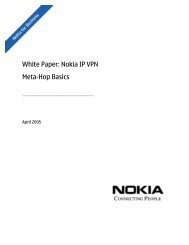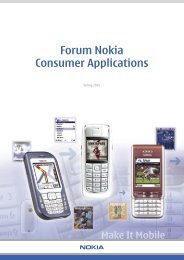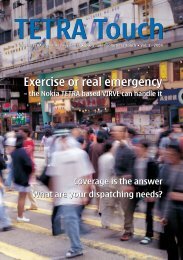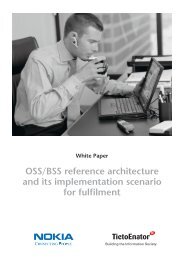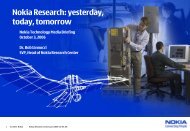Nokia Environmental Report 2002
Nokia Environmental Report 2002
Nokia Environmental Report 2002
Create successful ePaper yourself
Turn your PDF publications into a flip-book with our unique Google optimized e-Paper software.
<strong>Environmental</strong> <strong>Report</strong> <strong>2002</strong><br />
N O K I A - W I D E E N V I R O N M E N T A L P R O G R A M S<br />
Collection of environmental data<br />
<strong>Nokia</strong>’s Real Estate and Facilities function is responsible for<br />
the collection of environmental data from all <strong>Nokia</strong> sites<br />
with over 10 000 square meters in area. This arrangement<br />
makes sense as most of our environmental data pertains to<br />
real estate operations.<br />
<strong>Environmental</strong> data collection at the Group-level comprises<br />
water and energy consumption and waste and Ozone<br />
Depleting Substances (ODS). Aggregate <strong>Nokia</strong> figures are<br />
broken down into regional totals and for energy into totals<br />
for different types of energy. Comparisons to net sales are<br />
used as metrics for environmental data. Out-of-trend changes<br />
in comparisons to previous years are due to changes in<br />
measuring methods and the resulting improvement in the<br />
quality of the data.<br />
The collection system and metrics are under further development.<br />
<strong>Environmental</strong>ly relevant analyses of data are being<br />
developed at many <strong>Nokia</strong> sites. This includes the analysis<br />
and monitoring of the recycling rate of waste produced in<br />
our own operations.<br />
Risk management<br />
<strong>Nokia</strong> is adopting a common and systematic approach to<br />
management of all kinds of risks across all of our businesses,<br />
platforms and processes. The <strong>Nokia</strong> Risk Policy approved by<br />
the <strong>Nokia</strong> Board provides the basic guidelines of what risk<br />
and risk management means in practice for <strong>Nokia</strong>. Risk<br />
management is not a separate process or action but a normal<br />
business and management daily practice and is a normal<br />
management capability. All people in <strong>Nokia</strong> are responsible<br />
for identifying, raising to the attention of others and<br />
managing any risks firstly in their own area of responsibility<br />
and then in areas of the business that could affect <strong>Nokia</strong> as<br />
a whole.<br />
Return used<br />
phones, batteries,<br />
chargers and other<br />
accessories to a collection<br />
point for recycling.<br />
www.nokia.com/<br />
aboutnokia/environment<br />
32<br />
End-of-Life Practices<br />
End-of-life Practices (EoL) are aimed at the collection<br />
of equipment at the end of its service life with a view<br />
to recovering its material and energy content as well as<br />
ensuring the safe treatment of substances that may cause<br />
harm to people or the environment if not disposed of<br />
properly.<br />
The focus areas of our EoL development work are:<br />
• Recyclability of our own products through DfE<br />
• Monitoring and comparison of recycling systems<br />
• Monitoring and development of recycling processes<br />
in cooperation with recyclers<br />
After the WEEE directive entered into force, <strong>Nokia</strong> and other<br />
electronic producers are responsible for financing part of the<br />
collection, treatment and environmentally sound disposal<br />
of equipment sold under the <strong>Nokia</strong> brand. <strong>Nokia</strong> is preparing<br />
for this responsibility by improving the recyclability of<br />
its products through sound DfE and by participating in the<br />
development of take-back schemes. Design decisions on the<br />
material content and structural design of the products have a<br />
direct bearing on their recyclability and ease of disassembly.<br />
Reclamation of materials from electronic waste offers<br />
economic and environmental benefits. Precious metals<br />
in particular are commercially valuable. At the same time,<br />
proper treatment of substances that may cause harm during<br />
treatment or on disposal is of the essence. We have therefore<br />
formulated criteria for our approved EoL service providers.<br />
The WEEE directive allows different take-back and recycling<br />
arrangements in different countries. We have studied<br />
different alternatives in a number of pilot projects.<br />
<strong>Nokia</strong> Networks has offered its customers a recovery and<br />
recycling service, including site disassembly, transportation,<br />
selection of and contracts with authorized recyclers since<br />
1999.<br />
<strong>Nokia</strong>’s Internet site www.nokia.com/aboutnokia/environment<br />
gives consumers information about their nearest<br />
mobile phone and accessories collection point. Information<br />
is of great importance in motivating consumers to hand<br />
their phones back.<br />
Under <strong>Nokia</strong>’s basic take-back system, authorized repair<br />
shops have the readiness to take back mobile phones from<br />
individual consumers. Large consignments are handled by


